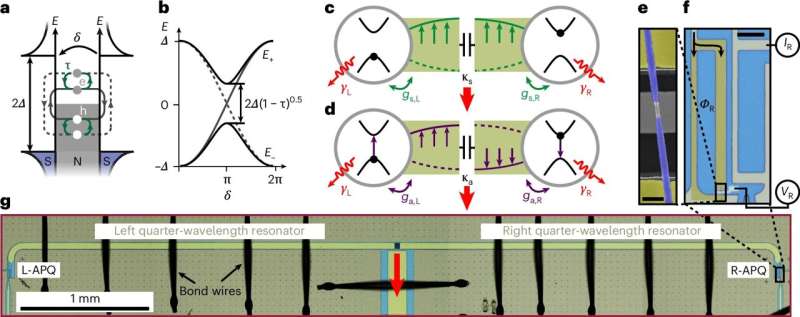
October 3, 2024 by University of Basel
Collected at: https://phys.org/news/2024-10-physicists-strong-coupling-andreev-qubits.html
Physicists from the University of Basel have succeeded in coupling two Andreev qubits coherently over a macroscopic distance for the first time. They achieved this with the help of microwave photons generated in a narrow superconducting resonator. The results of the experiments and accompanying calculations were recently published in Nature Physics, laying the foundation for the use of coupled Andreev qubits in quantum communication and quantum computing.
Quantum communication and quantum computing operate based on quantum bits (qubits) as the smallest unit of information—related to bits in a classical computer. Of the many different approaches currently being investigated around the world, one promising option is to use Andreev pair qubits.
These qubits are formed at interfaces between a metal and a superconductor in a process known as Andreev reflection. Here, an electron from the metal enters the superconductor, where it becomes part of an electron pair (a Cooper pair)—while a hole, which behaves like a positive particle, is reflected back into the metal.
Based on this process, discrete pairs of bound states are formed at the interface of these materials. They are known as Andreev bound states and can serve as the basis states of a qubit. These states are relatively robust to outside perturbations, and the coherence time—the time for which superposition is maintained—is relatively long. They can also be readily controlled and incorporated into modern electronic circuits. All of these factors are advantageous for developing reliable and scalable quantum computers.
Exchange between two quantum systems
The researchers have now achieved a strong quantum mechanical coupling between two Andreev qubits, each localized in a semiconducting nanowire. The results show excellent agreement with theoretical models.
“We coupled the two Andreev pair qubits at a large distance from one another at the two ends of a long, superconducting microwave resonator. This allows the exchange of microwave photons between the resonator and the qubits,” explains Professor Christian Schönenberger from the Department of Physics and the Swiss Nanoscience Institute of the University of Basel, whose team carried out the experiments.
The microwave resonator can be used in two different ways: In one mode, the qubits can be read out via the resonator, providing the researchers with information on their quantum state. A second mode is used to couple the two qubits to each other, allowing them to “communicate” without losing microwave photons. The two qubits are then no longer independent of one another but rather share a new quantum state—which is vital for the development of quantum communication and quantum computers.
“In our work, we combine three quantum systems so that they can exchange photons between each other. Our qubits themselves are only about 100 nanometers in size, and we couple them over a macroscopic distance of 6 millimeters,” says Dr. Andreas Baumgartner, one of the article’s co-authors. “By doing so, we were able to show that Andreev pair qubits are suitable as compact and scalable solid-state qubits.”
More information: L. Y. Cheung et al, Photon-mediated long-range coupling of two Andreev pair qubits, Nature Physics (2024). DOI: 10.1038/s41567-024-02630-w
Journal information: Nature Physics

Leave a Reply